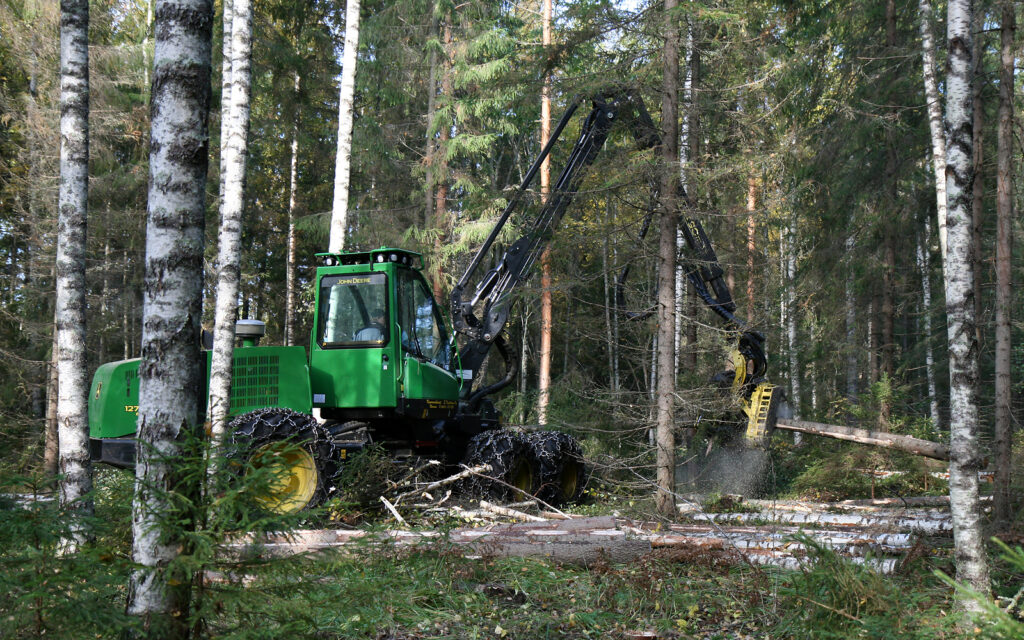Clearcut areas are astonishingly small

Clearcut areas in Finland are smallest in family forests in the south, 1.2 hectares on average. The average for the whole country is only 1.5 hectares.
Clearcut areas in the south are traditionally smaller than in the north. The areas in family-owned forests are also smaller in comparison with other forest owners. Surprisingly, the average for all forest owners in the north is only slightly over two hectares as well.
Individuals and families own some two thirds of the Finnish forests.
Large clearcutting areas are traditionally considered a problem with regard to biodiversity. Regardless of whether it is a problem or not, it cannot be as big a problem as has been thought. One should also take into consideration that clearcutting in Finland does not mean total clearcutting: forest certification adopted some 15 years ago requires that one must, in connection with clearcutting, leave at least 5–10 retention trees on every clearcut hectare.
These trees may never be removed from the forest and they are very significant for maintaining forest biodiversity.
Clearcut area is defined by the nature
Forestry activities in Finland are carried out according to forest compartments. A forest compartment is an area that is defined according to the natural characteristics – microclimate, eutrophicity, growing stock – of the area. Thus, clearcutting areas are not defined arbitrarily but according to guidelines given by the nature.

The small size of the compartments increases costs of forestry activities. ”Yes, it can be a problem for whoever purchases or harvests the timber, but not necessarily for the forest owner,” says Mr. Erno Järvinen, research specialist at the Central Union of Agricultural Producers and Forest Owners (MTK).
However, the size expressed above cannot be considered as large. ”No, not really. But this is understandable, knowing that according to evaluations, we have eight million forest compartments in our commercial forests,” says Järvinen.
”It is not the small compartment, but the small holding”
Mr, Jorma Länsitalo, Head of the Forestry Unit at Stora Enso Finland says that as such, small compartments are not necessarily a problem, but the small scale of forest ownership. Thanks to modern harvesting technology, smaller clearcuts are now more profitable to carry out.

”The smaller the forest holding, the fewer are the times the owner sells timber. This is when the right moment of selling becomes more and more important,” says Länsitalo.
This being the case, the forest owners start to behave very similarly as a group. ”Their perceptions tend to move into the same direction. This means that everybody wants to sell, and not to sell at the same time,” says Länsitalo.
This in turn means large fluctuation in the supply of wood. This is a problem for the industry, which needs a stable supply and flow of timber.
Small compartment increases costs
However, Länsitalo admits that the small compartments create additional costs for forestry activities.
The limit, below which the unit costs start to increase rapidly, is somewhere around 1.2 hectares.
One reason is that the machinery must be transported from one compartment to another.
”The smaller the work between the transports, the larger is the share of time of transports. And, during transport the machinery does not, of course, produce anything,” says Mr. Simo Jaakkola, Deputy Managing Director of the Finnish Forestry and Earth Moving Contractors.
The forest owner can also carry out forestry activities on several compartments at the same time, which decreases the costs. According to Jaakkola, it is not worth while to drive with a forestry machine more than a couple of hundred of meters.
”One could say, that nowadays we have to transport the machinery roughly every third day,” says Jaakkola.
Kirjoita kommentti